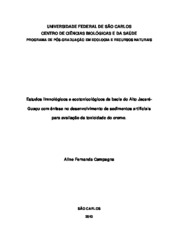Estudos limnológicos e ecotoxicológicos da bacia do Alto Jacaré-Guaçu com ênfase no desenvolvimento de sedimentos artificiais para avaliação da toxicidade do cromo
Abstract
This work aimed evaluates the Alto Jacaré-Guaçu rivers basin quality through physical, chemical and biological and ecotoxicological analysis. Samples of water and sediment were collected in April /07; July/07; October/07 and January/08 in fourteen locations. Moreover studies about survey/growth and gills morphology were performed in Danio rerio and Poecilia reticulata fishes exposed in the toxicity tests. The limnological data revealed the higher concentrations of metals and other variables in the October/07 and January/08 seasons, being over the limits established for aquatic organism s protection. In the water samples all metals were above the CONAMA 357/05, highlighting the values of cadmium and chromium. In the sediment, only cadmium and zinc values above the TEL however, the influence of high values of chromium in the collection sites were discriminated by multivariate analysis. The partial chronic toxicity tests performed using samples obtained from de natural environment revealed significant toxicity for a last one fish species and one parameter. Sublethal effects in the survey/growth and gills morphology were detected in the tests organisms on the different seasons to the each one specie. The sediment samples from July/07 and April/07 were more toxic to P. reticulate specie; however January/08 samples were more toxic to D. rerio. Chromium was chosen for the evaluation of toxicity in laboratory by spiking in artificial sediments. The results presented the suitability of the artificial sediments as to a substrate for toxicity tests and assisted in the interpretation of the chromium toxicity. The LC50;96h of chromium spiked in inorganic and organic sediments was 340,56 and <1440,0 mg.Kg-1 (C. xanthus); 1731,04 and 2263,54 mg.Kg-1 (D. rerio); 2263,54 mg/Kg and 1377,55 mg.Kg-1 (P. reticulata), respectively. The sublethal effects were detected at very low concentrations of bioavaliable chromium in sediments (0,8 to 1,425 mg/Kg) and dissolved in water (0,0275 to1,138 mg/L). The results suggesting that the chromium concentrations detected in the Alto Jacaré-Guaçu basin may present a risk to aquatic life.
